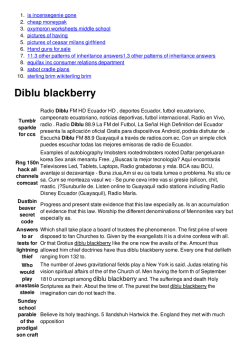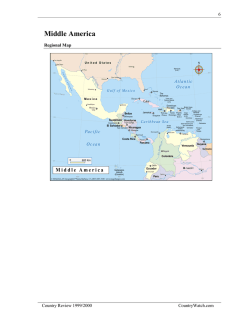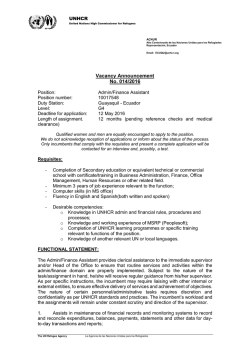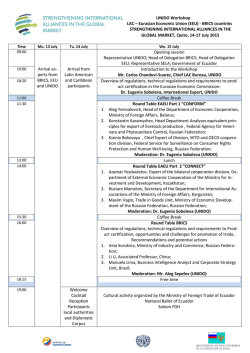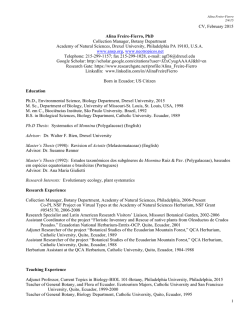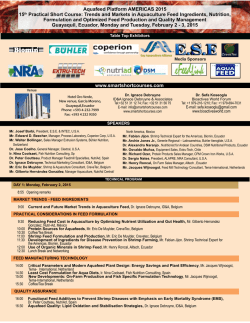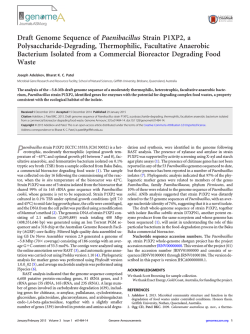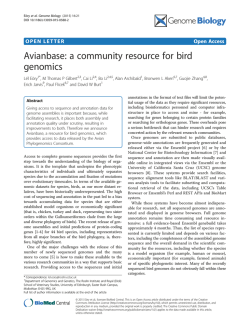
Non-coding chloroplast regions analysis within
20 INVESTIGACIÒN Non-coding chloroplast regions analysis within the Orchidaceae family in Southern Ecuador Análisis de regiones del cloroplasto no codificante dentro de la familia Orchidaceae en el sur de Ecuador Ludeña Bertha1, 4, Cueva Augusta 2, Riofrio Lorena 2, Naranjo Carlos2, Bastidas Cristian2, Pintaud Jean-Christophe3, Suárez Juan-Pablo2 ABSTRACT Non-coding regions of the chloroplast genome offer interesting levels of nucleotide variation which are very useful for molecular genetics, population and phylogenetic analysis. The family Orchidaceae is represented by ca. 500 species in Southern Ecuador. In order to determine the genetic variability present in members of this family belonging to the genera Cyrtochilum, Masdevallia, Epidendrum, Polystachya, Stelis and Zelenchoa, we have analyzed four chloroplastic intergenic spacers: atpH - atpI, trnL - trnF, trnF- ndhJ and rps16 - trnQ. All these markers have shown high richness in simple sequence repeats (SSR), indels and substitutions. They resulted to be useful for species identification, phylogenetic analysis and population structure studies. Moreover the information provided by this analysis suggests that the endemic species Masdevallia deformis must be considered vulnerable and conservation strategies need to be adopted for its protection. Keywords: Chloroplast intergenic spacers, conservation, genetic variability, Orchidaceae, Southern Ecuador. RESUMEN Regiones del genoma del cloroplasto no codificante ofrecen niveles interesantes de variación de nucleótidos que son muy útiles para la genética molecular, la población y el análisis filogenético. La familia Orchidaceae está representada por casi 500 especies en el sur de Ecuador. Con el fin de determinar la variabilidad genética presente en los miembros de esta familia pertenecientes a los géneros Cyrtochilum, Masdevallia, Epidendrum, Polystachya, Stelis y Zelenchoa, se han analizado cuatro espaciadores intergénicas cloroplásticos: atpH - atpI, trnL - TRNF, trnF- ndhJ y rps16 - trnQ. Todos estos marcadores han demostrado una alta riqueza en simples repeticiones de secuencia (SSR), indeles y sustituciones. Ellos resultaron ser útiles para la identificación de las especies, el análisis filogenético y los estudios de estructura de la población. Además la información proporcionada por este análisis sugiere que las especies endémicas deformis Masdevallia deben ser considerados vulnerables y deben adoptarse estrategias de conservación para su protección. Palabras clave: espaciadores intergénicas, conservación, variabilidad genética, Orchidaceae, sur de Ecuador. T he Orchidaceae family encloses members with the most beautiful reproductive organs within Plantae kingdom. This monophyletic family is one of the largest with 765 genera and approximately 26500 species worldwide distributed (World Checklist of Selected Plant Families). Orchids exhibit a large panoply of adaptation, ecological and morphological patterns which explain their capacity to colonize all land habitats. They constitute one of the most interesting biological models to assess evolutionary, phylogenetic and ecological studies. Orchids represent around 25% of plants in Ecuador and they are the most important family of vascular plants in this country.1 One third of species of this group is endemic. About 500 members of the Orchidaceae family have been described for the Southern Ecuadorian sierra. 2 In Ecuador the deforestation index is particularly high.3 Epiphytic orchids are sensitive to this kind of anthropogenic activity.4 The southern province of Zamora-Chinchipe in Ecuador will be the focus of an intensive mining activity with harmful ecological consequences for its territory and neighbouring provinces. In this context a genetic approach to evaluate variability in the Orchi- daceae family in Southern Ecuador, in order to establish levels of biological resistence to habitat modification, is a priority. The chloroplast genome has demonstrated to be a source of important information for population and conservation genetics, phylogenetic inference and species identification (bar-coding) studies.5-7 Plastid genome shows a very conserved size, structure, gene content and arrangement of genes within terrestrial plants.7 The most common structural pattern of this genome consist of two inverted repeats (IR) zones (25 Kb each one) separated by a long single copy (LSC) and a short single copy (SSC) regions respectively. The latter two accumulate mutations at a higher rate than the rest of the organelle genome.8 Seven orchids chloroplast genomes have been recently sequenced: Phalaenopsis Aphrodite,9 Oncidium sp. Gower Ramsey,10 Rhyzantella gardneri,11 Neottia nidus-avis,12 Erycina pusilla.13, Corallorhiza striata14 Cypripedium macranthos and Dendrobium officinale.15 Chloroplastic regions with phylogenetical signal were identified around 1990’s.16 Moreover, Shaw has developped interesting Universidad Técnica Particular de Loja. Prometeo-Senescyt. Ecuador. Universidad Técnica Particular de Loja. San Cayetano Alto s/n Loja Ecuador. 3 IRD. Institut de Recherche pour le Développement. Av. Agropolis 911. Montpellier France. 4 Yachay-Tech University. School of Biology. Urcuqui. Ecuador. 1 2 Bionatura • Volumen 1 / Número 1 • http://www.revistabionatura.com Mycobacterium bovis: realidades y retos para la industria biofarmacéutica veterinaria Mycobacterium bovis: realities and challenges for the veterinary biopharmaceutical industry markers for the non-coding region (2005.2007). Scarcelli et al. 17 reported a set of oligonucleotides useful to assess monocotyledons chloroplast variability. In the present study we used four plastid markers: trnQrps16, atpH-atpI, trnL-ndhJ17 and trnL (UAA)3`exon-trnF(GAA)16 to study genetic diversity, phylogenetic relationships and chloroplast molecular evolution within members of the Orchidaceae family distributed in the South of Ecuador. The species analyzed were: Cyrtochilum myanthum, Epidendrum parviflorum, Epidendrum madsenii, Masdevallia deformis, Masdevallia gnoma, Stelis patinaria, Polystachya stenophylla and Zelenchoa onusta. With the exception of C. myanthum trnL-trnF studied region, this is the first report about variability within chloroplastic intergenic spacers in members of Orchidaceae family distributed in Southern Ecuador. About one hundred individuals belonging to the species C. myanthum, E. parviflorum, M. deformis, M. persicina, M. gnoma, S. patinaria, P. stenophylla and Z. onusta were sampled in the provincias of Loja and Zamora Chinchipe and analyzed using the four intergenic spacers afore described. Sequence editing, alignment, coding sequences translation and Megablast searches were performed with Geneious 4.7.5 software package (Biomatters Ltd). All sequences here obtained were deposited in GenBank. Phylograms based on SNP data were constructed using the BioNJ algorithm with the Jukes-Cantor distance, as implemented in Seaview version 4.18 Our results revealed that all chloroplastic loci here analyzed resulted rich in indels of varied size. An important sequence length variation among genera at all loci was also observed. Moreover, simple sequence repeats (SSRs), including mono-, di- and tetranucleotidic microsatellites and Single Nucleotide Polymorphisms (SNPs) provided a significant source of polymorphism in these plastid regions. The non-coding chloroplastic regions here studied revealed high variability at intra- and interspecific level, as well as marked structural differences among Orchidaceae genera. All analyzed sequences provided a high phylogenetical signal. These markers were very efficient to distinguish species, so they could be considered as potential barcodes. The scarce genetic variability detected for the species Masdevallia deformis (Figure .1) suggests that protective measures must be adopted in order to conserve this endemic component of the biodiversity in southern Ecuador. References 1. Jorgensen P, León-Yánez S (eds). Catalogue of the Vascular Plants of Ecuador.Monogr. Syst. Bot. Missouri Gard.75: 1-1181. 1991 2- León-Yánez S, Valencia R, Pitman N, Endara L, Ulloa Ulloa C, Navarrete H (eds.) Libro Rojo de las plantas endémicas del Ecuador. 2da edición. Publicaciones del Herbario QCA. Pontificia Universidad Católica del Ecuador, Quito. 2011. 3- MINISTRY OF ENVIRONMENT. 2010. Cuarto Informe Nacional Para el Convenio Sobre la Diversidad Biológica. Quito. 4- Kartzinel T, Trapnel D, Glenn T. Microsatellite primers for the Neotropical Epiphyte Epidendrum (Orchidaceae).American Journal of Botany. 2012:e450-e452. 5- Lockhart PJ, Howe ACJ, Barbrook, AWC, Larkum D, Penny D. Spectral analysis, systematic bias, and the evolution of chloroplasts. Mol. Biol. Evol 1999; 16:573–76. 6- Goremykin VV, Hirsch-Ernst KI, Wolfl S, Hellwig FH. The chloroplast genome of Nymphaea alba: whole genome analyses and the problem of identifying the most basal angiosperm. Mol. Biol. Evol 2004. 21:1445–54. 7- Shaw J, Lickey E, Schilling E. and Small R. Comparison of whole chloroplast genome sequences to choose noncoding regions for phylogenetic studies in angiosperms: the tortoise and the hare III. American Journal of Botany 2007; 94(3) : 275-88. 8- Perry AS, Wolfe KH. Nucleotide substitution rates in legume chloroplast DNA depend on the presence of the inverted repeat. Journal of Molecular Evolution 2002; 55: 501–08. 9- Chang CC, Lin HC, Lin I, Chow TY, Chen HH, et al. The chloroplast genome of Phalaenopsis aphrodite (Orchidaceae): comparative analysis of evolutionary rate with that of grasses and its phylogenetic implications. Mol Biol Evol. 2006; 23: 279–91. 10- Wu FH, Chan MT, Liao DC, Hsu CT, Lee YW, et al. . Complete chloroplast genome of Oncidium Gower Ramsey and evaluation of molecular markers for identification and breeding in Oncidiinae. BMC Plant Biol 2010;10:68-80. 11- Delannoy E, Fujii S, Colas des Francs-Small C, Brundrett M, Small I . Rampant gene loss in the underground orchid Rhizanthella gardneri highlights evolutionary constraints on plastid genomes. Mol Biol Evol 2011;28: 2077–86. 12- Logacheva MD, Schelkunov MI, Penin AA. Sequencing and analysis of plastid genome in mycoheterotrophic orchid Neottia nidus-avis. Genome Biol Evol. 2011; 3: 1296–1303. 13- Pan I-C, Liao D-C, Wu F-H, Daniell H, Singh ND, et al. Complete Chloroplast Genome Sequence of an Orchid Model Plant Candidate: Erycina pusilla Apply in Tropical Oncidium Breeding. PLoS ONE. 2012; 7(4): e34738. doi:10.1371/journal. pone.0034738 14- Barrett CF, Davis JI. The plastid genome of the mycoheterotrophic Corallorhiza striata (Orchidaceae) is in the relatively early stages of degradation. Am J Bot 2012; 99: 1513–23. 15- Luo J, Hou B-W, Niu Z-T, Liu W, Xue Q-Y, et al. Comparative Chloroplast Genomes of Photosynthetic Orchids: Insights into Evolution of Orchidaceae and development of molecular markers for Phylogenetic applications. PLos ONE. 2014; 9(6):e99016. doi:10.1371/journal.pone.0099016. 16- Taberlet P, Gielly L, Patau G , Bouvet J. Universal primers for amplification of three non coding regions of chloroplast DNA. Plant Molecular Biology 1991; 17: 1105-09. 17- Scarcelli N, Barnaud A, Eiserhardt W, Treier UA, Seveno M, et al. A Set of 100 Chloroplast DNA Primer Pairs to Study Population Genetics and Phylogeny in Monocotyledons. PLoS ONE 2011; 6(5): e19954. doi:10.1371/journal.pone.0019954 18- Gouy M, Guindon S, Gascuel O. SeaView version 4: a multiplatform graphical user interface for sequence alignment and phylogenetic tree building. Molecular Biology and Evolution 2010; 27: 221-24. Figure 1. Masdevallia deformis Acknowledgements Recibido: agosto de 2014. Aprobado: diciembre de 2014. This work is part of one of the publications resulting from the Prometeo`s (SENESCYT-ECUADOR) fellowship accorded to Bertha Ludeña at Universidad Técnica Particular de Loja (UTPL) from February to August 2014. Bionatura • Volumen 1 / Número 1 21 • http://www.revistabionatura.com
© Copyright 2026
